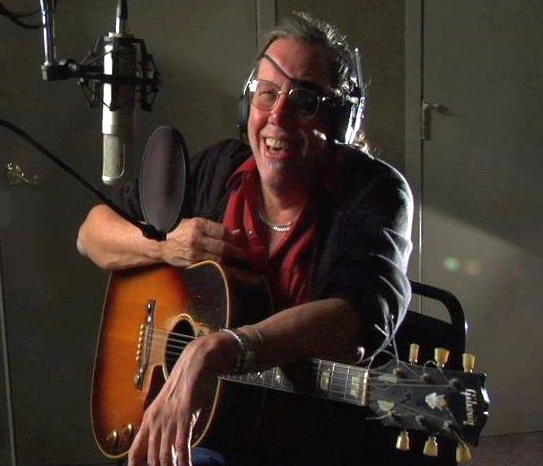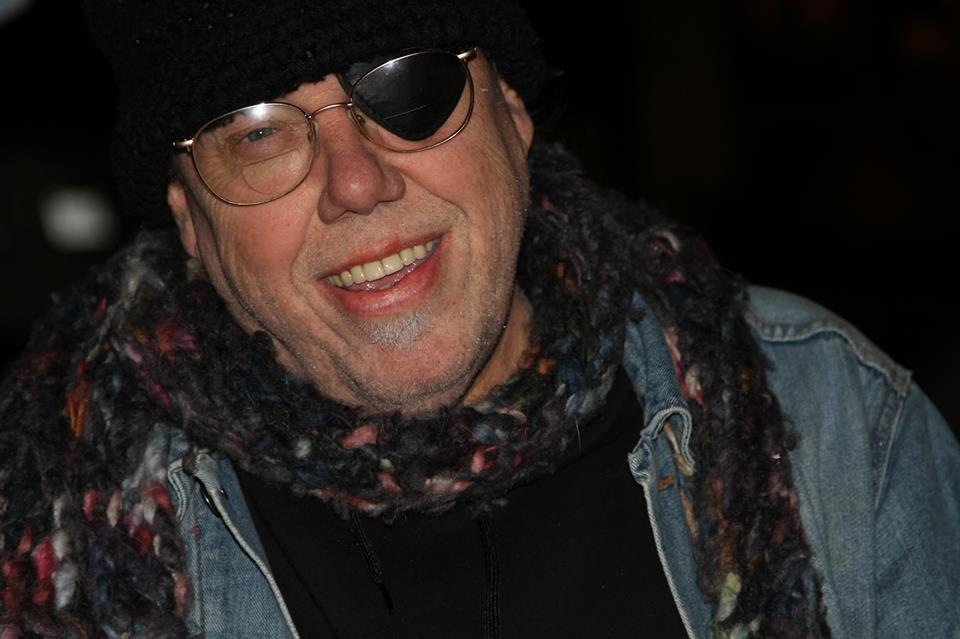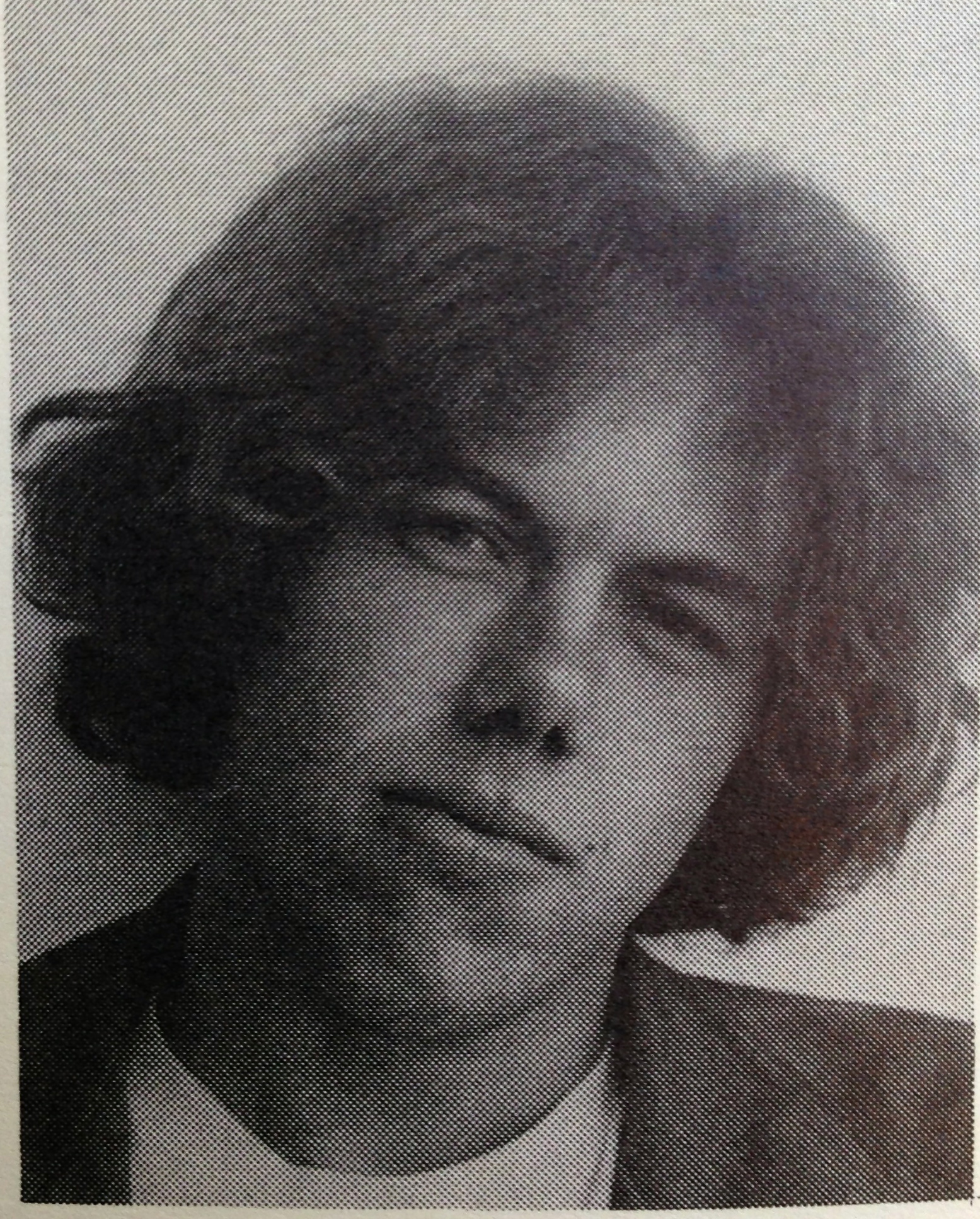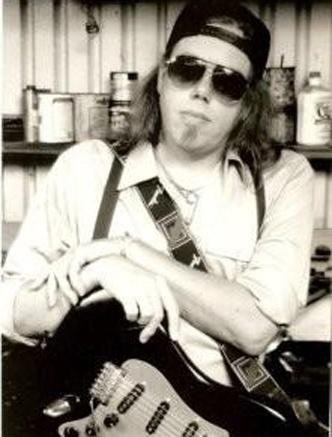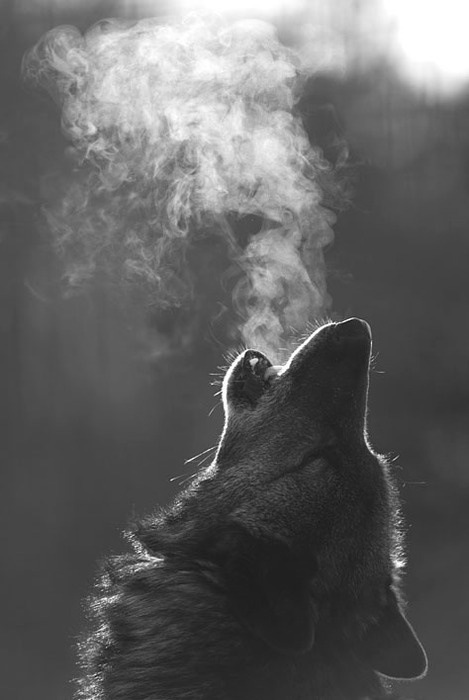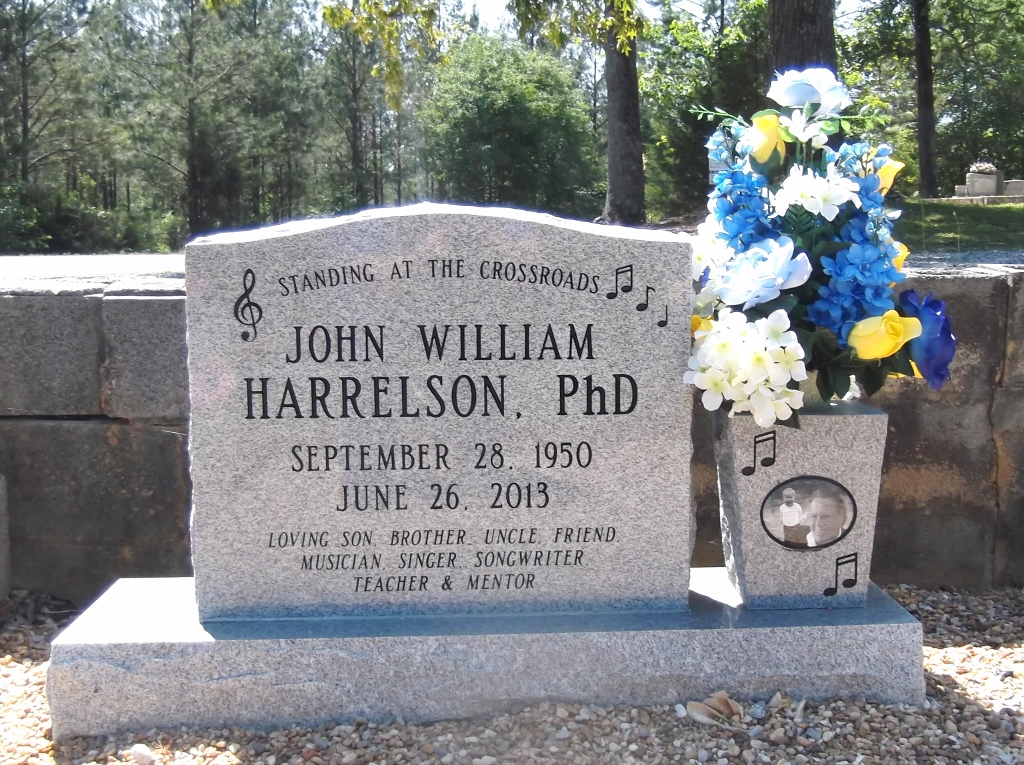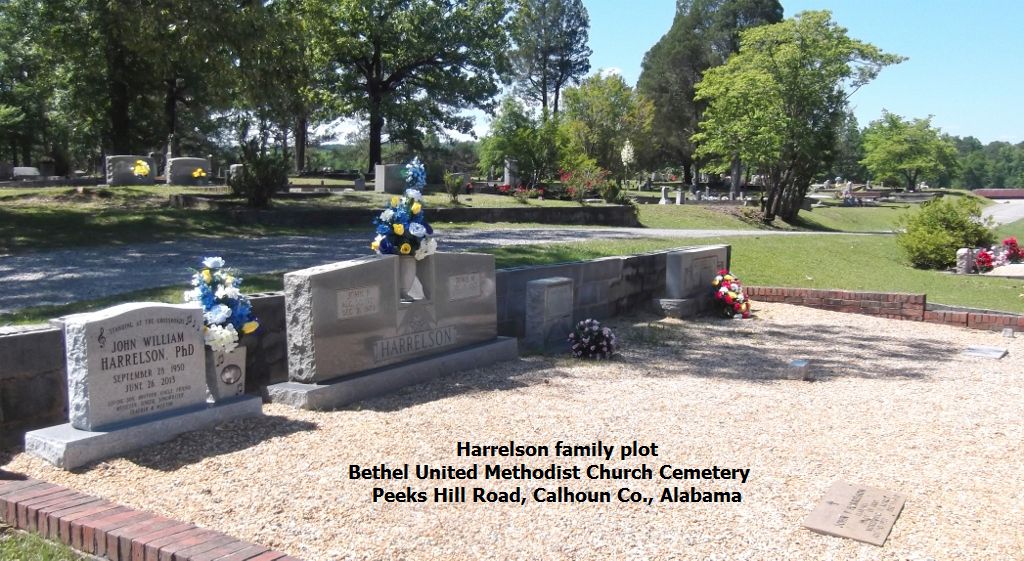July 05, 2013 9:30 AM
Musician
John William Harrelson, a legendary fixture in Claremont's music scene, died on June 26, 2013 in Upland, California. He was 62.
Mr. Harrelson was born on September 28, 1950 in Gadsden, Alabama to Doris Elizabeth Harrelson (Martin) and John Pershing Harrelson. He spent his first years in surroundings marked by his father's pecan orchards, creeks perfect for fishing and the occasional passage of trains on the Louisville & Nashville Railroad.
Before long, Mr. Harrelson's father found work in the Kaiser Steel mill in Fontana and the family packed up and moved to southern California. Mrs. Harrelson got a nursing degree just after World War II and put it to use when her husband and his co-workers went on strike at the Kaiser plant. At first, her position at San Antonio Hospital was a stopgap measure, but she ended up working there for the next 30 years.
Mrs. Harrelson worked a graveyard shift so the children spent a lot of time with their dad, who had a keen appreciation of music. Susan Culbertson, Mr. Harrelson's sister, remembers their father spinning records on the hi-fi: Harry Belafonte's Calypso tunes, Hank Williams country songs and hits like "The Girl from Ipanema" and "El Paso." He also loved poetry and taught his children to recite classics like Edgar Allen Poe's "The Raven," Rudyard Kipling's "Mandalay" and Alfred, Lord Tennyson's "The Charge of the Light Brigade."
He also passed on something less than melodious, according to Ms. Culbertson, who is 3 years younger than her brother: "We grew up with sarcasm and wit and irony." Nonetheless, young John evinced an early aptitude for music. He played trumpet in his elementary school orchestra and eventually cajoled his father to buy his first guitar. From his early teens on, Mr. Harrelson was always in a band.
Ms. Culbertson shared an early example of her brother's musical proclivity. When she was 10, her mother bought a piano and engaged a neighborhood woman to give her lessons.
"I kind of plugged along and did what my mother wanted me to," she said. "But one day John sat down and started playing, and that was kind of it."
Roger Tessier—a longtime friend who would go on to produce and co-direct the 2012 documentary Dead Man Rockin': John Harrelson's Life in Music—first met Mr. Harrelson when his band was performing outside of a White Front department store in Ontario.
"There was this skinny kid introducing the acts. He had affected this British accent and had on a John Lennon hat. He said, ‘'Allo everybody. This next band is going to be wonderful," Mr. Tessier recalled. "I thought, I want to know who this kid is."
Mr. Harrelson, then at Chaffey High School, and Mr. Tessier formed a band called M'Lords, along with Mr. Harrelson's drummer friend Michael Monteleone.
"We fancied ourselves the mods," Mr. Tessier laughed. "We were playing American blues music and British rock and roll. It was a strange combination to see 3 suburban kids belting out the blues."
They were a true garage band, according to Ms. Culbertson.
"They practiced in the garage at my house and we would have police come and tell us to be quiet, because the neighbors were complaining," she said.
Though Mr. Harrelson's voice was not as gravelly as it would become in later years, "It was a blues voice from the beginning," Ms. Culbertson recalled. "Because I'm the sister, I never got the attraction. I was like, ‘Eww, really?'"
In the film Dead Man Rockin', Mr. Harrelson—who over the years wrote some 4500 songs—recalled how he first began to write lyrics. He was sitting in a friend's backyard when The Rolling Stones' "Heart of Stone" came on the radio. Mr. Harrelson was listening to the words—"There've been so many girls that I've known/I've made so many cry and still I wonder why…"—when it hit him that the lyrics were like someone's diary entry. And yet they were more effective than the contrived fare that dominated American airwaves at the time.
"I looked at my poetry and said, I want to be Edgar Allen Poe and I want to be Alfred, Lord Tennyson," Mr. Harrelson said. "I'm not. I'm probably not gonna be. But you know what? I can write some f—-ing rock ‘n roll songs.
With the addition of rhythm guitarist Jessie "Ron" Turnbow, the group morphed into The Southe, a band that played together until January of 1968 when Mr. Tessier joined the Air Force. It wasn't long before Mr. Harrelson formed a new band. Featuring Mr. Harrelson on vocals and harmonica, Bob Brink on guitar, Ray Konkel on bass and Mr. Monteleone as drummer, it was called Hard Luck Boy.
Hard Luck Boy was playing a gig at USC when the band was discovered by a promoter with big connections. From 1968 to 1969, Hard Luck Boy opened for an array of famous acts, including Led Zeppelin, Janis Joplin, the Paul Butterfield Blues Band, John Mayall and the Bluesbreakers, The Animals, Buffalo Springfield, Iron Butterfly, Jefferson Airplane, Chicago, Canned Heat, Three Dog Night, Credence Clearwater Revival, The Flying Burrito Brothers, MC5 and Procul Harum.
Hard Luck Boy was managed by Claremonter John Neiuber. He met Mr. Harrelson in 1965 or 1966 and they bonded over their love of music, with Mr. Harrelson schooling Mr. Neiuber in blues legends like Muddy Waters and Mr. Neiuber sharing his extensive soul music collection.
Touring was hard work, but the group enjoyed audiences of thousands, the chance to hear unforgettable performers and some raucous after-parties. When you're 18 or 19, Mr. Neiuber noted, "You don't look down, and you don't know what you don't know."
In 1968, Mr. Harrelson was approached by 2 A&R men from Dot Records with a Faustian bargain. They would sign Mr. Harrelson, provided that he ditch his drummer and guitar player. Mr. Harrelson, sure more such opportunities would come his way, refused to betray his bandmates. In fact, his time with Hard Luck Boy, which disbanded on its own after 10 months, would represent the zenith of his commercial success.
Mr. Harrelson continued to make music, mastering 20 instruments and playing in a variety of bands over the years, ranging from rock to blues to country to jazz to Big Band.
"A phase? It was his life. Music was it," Ms. Culbertson said. "Everything else that people accumulate in life or accomplish in life—house, kids, a dog, a wife—came second."
Not content to make music, Mr. Harrelson wanted to know everything about it and share his passion with others. He had received his undergraduate degree from Pitzer College and went on to earn a doctorate in ethno-musicology from Claremont Graduate University. He taught classes like the History of Rock ‘n Roll at schools like Citrus College and Santiago Canyon College. He also gave guitar lessons at the Folk Music Center and later from his own home. Ben Harper, the grandson of Folk Music Center founders Charles and Dorothy Chase, credits Mr. Harrelson as an influence and inspiration.
"It's a soulfulness. It's a depth," he said of Mr. Harrelson's sound. "John is a true blues man. Everything he plays, you want to hear more of."
Mr. Harrelson also impacted people when he was just hanging out. Robin Young, the talent buyer at The Press Restaurant in Claremont, first met Mr. Harrelson when she was working at Nick's Café.
"He would come to Nick's and have many cups of coffee and cigarettes and grade papers and sort of regale people," she said. "He was a fulcrum for very intelligent conversation and brought together as a hub people who would not have become friends otherwise."
Her friendship with Mr. Harrelson continued when she moved on to The Press about 11 years ago. He provided guidance when she was first organizing the eatery's music program. He was also an active participant at the Press' ongoing Sunday Night Jam.
"He had an intensity. I remembered thinking at the time that it was almost like he was out of place, that he was too much for a little sleepy town," Ms. Young recalled. "As I got to know him, I realized that it wasn't a put-on of any kind. He was genuine, authentic. He was the real deal."
Mr. Harrelson had 2 great challenges in his life. The first was the inability of his musical career to live up to his dreams. He once pictured himself jamming with the likes of Howlin' Wolf and the Stones, and having some 100 of his songs hit it big. When success and money failed to fall on his doorstep, he spent his life "shooting for the moon but always surviving."
His second and abiding trial was poor health. Mr. Harrelson's father died at age 49, and he inherited the same heart problems and diabetes that plagued the elder Mr. Harrelson. He had his first heart attack at age 37 and by 40 had undergone a quadruple bipass. At 43, he was diagnosed with diabetes, a condition that would get progressively worse.
In December of 2006, he flat-lined twice due to 2 different illnesses. After these brushes with death, he had to wear an eye patch because he could only focus one eye at a time. His circulation was so bad that, not long after, he had to have one of his feet amputated.
As the precariousness of Mr. Harrelson's health became evident, friends grew concerned about his musical legacy. In 2004 or 2005, Mr. Neiuber talked to Mr. Harrelson and said, "You've got all this music. Let's get in the studio again and do some CDs and get it out there."
Over the years, they gathered to record albums like Cottonmouth Revelator, Streets of Heart and Lust and Doc H and the Rio Laudanum Cowboys. They immortalized dozens of bluesy gems like "I Want Your Ass," "Fire and Gasoline" and "Long Distance Call." These plus the double album that accompanies Dead Man Rockin', all released under Mr. Nieuber's Rubicon Recordings imprint (www.rubiconrecordings.com), are available at Rhino Records as well as for purchase and download at online stores like Amazon.
Mr. Neiuber considers it an honor to have helped preserve Mr. Harrelson's unique voice.
"John was a musical genius," he said. "His guitar phrasing, his lyrics and his melodies are incredible."
In 2005, Mr. Tessier was reunited with Mr. Harrelson, whom he hadn't seen since the ‘70s. Mr. Harrelson noted that a couple of his students were interested in making a documentary about his life. Mr. Tessier, who had dabbled in screenwriting and film production, was intrigued. He said he'd love to be part of the project and got a hold of the 2 students. After a while, the students' focus flagged and Mr. Tessier nearly gave up on the project.
Fate intervened when Mr. Tessier, who had grown nostalgic about his old garage band days, looked up his drummer from The Southe. He found Michael Monteleone, who he hadn't seen since 1968, on Facebook and discovered that he was now a filmmaker with his own production company. When they reconnected, Mr. Tessier mentioned the stalled John Harrelson documentary and Mr. Monteleone expressed an interest.
"I'd always felt John deserved a larger audience," Mr. Tessier said. "I said I'd be more than willing to take up the flame again."
Between 2010 and 2012, they filmed hours of interviews with Mr. Harrelson and with those who have felt his influence. They located Mr. Turnbow for a reunion performance by The Southe featuring a newly-penned song by Mr. Harrelson called "When You Come Back Home." The filmmakers also organized a live concert by Mr. Harrelson and his band The Revelators, which was filmed at The Press.
The documentary made its local debut at The Press and its festival debut at the American Documentary Film Festival in Palm Springs. It has since screened at the LA Indie Film Festival and at the Chicago Music and Film Festival. Dead Man Rockin' has been accepted to several other festivals and Mr. Tessier and Mr. Monteleone are in talks with a distribution company that hopes to make the documentary available online. For updates, visit www.deadmanrockin.com or the Dead Man Rockin' Facebook page.
Mr. Tessier was most nervous, he noted, when it came to debuting the documentary for Mr. Harrelson.
"He was adamant: This is your project, guys—sink or swim. I'm still gonna be John Harrelson no matter what," Mr. Tessier remembered. "John had been screwed over too many times. I felt I had his legacy in my hands."
An inkling of the deep impression Mr. Harrelson has made can be found on his Facebok personal page, which has been flooded with well-wishes since his death. Ms. Culbertson is delighted with the attention and has hopes that, between the documentary and his albums, Mr. Harrelson will gain some new fans.
"The ultimate irony, and who didn't know this, is that now that he's dead, he'll become famous," she said.
Mr. Harrelson was preceded in death by his father, John Pershing Harrelson of Ontario, California. He is survived by his mother, Doris Harrelson of Ontario, and by his sister Susan Culbertson, his brother-in-law Rob Culbertson, his nieces Roxy and Madeline Culbertson, and his nephew Max Culbertson, all of Rancho Cucamonga, California. He is also survived by many relatives in Alabama and by his lifelong friend John Neiuber of Claremont.
A viewing/visitation will be held at Collier-Butler Funeral Home, Gadsden, Alabama on July 9 from 6 to 8 p.m. Services will be held on July 10 at 2 p.m. at Bethel United Methodist Church, Calhoun County, Alabama, with burial following immediately in the church cemetery. A celebration of Mr. Harrelson's life, to be held locally, will be announced at a later date.
~ Sarah Torribio
[email protected]
________________________________________________
Musician John Harrelson dies at 62
David Allen, Staff Writer
Inland Valley Daily Bulletin July 2, 2013.
John Harrelson was a Chaffey High freshman when the Beatles hit the airwaves. Like a lot of young men, he was inspired to learn to play guitar and join a band.
Harrelson, however, never put the guitar down to grow up and move on. He spent the rest of his life earning a living from his craft: writing songs, performing, touring and recording.
Harrelson, who was beset with health problems in recent years, died Wednesday at an Upland rehabilitation center. The Ontario resident was 62.
"John was a musical genius. I don't say that lightly," said John Neiuber, his best friend, producer and onetime manager.
Harrelson could play 20 different instruments, notably guitar, bass, pedal steel, piano, violin and saxophone. He had a doctorate in ethnomusicology from Claremont Graduate University and taught music and music history at numerous colleges. And he wrote more than 4,500 songs.
At Chaffey he was in a garage band named The Southe with classmates Roger Tessier, Michael Monteleone and Ron Turnbow. After high school Harrelson led Hard Luck Boy, a blues-based rock band that opened concerts throughout the Southwest for such acts as Led Zeppelin, Janis Joplin, the Paul Butterfield Blues Band and John Mayall.
He was approached by Dot Records about a solo contract. Harrelson stayed loyal to his band, which proved to be a career mistake.
"This won't be my only shot," Harrelson later said of his thinking at the time. Unfortunately, it was.
But he persevered, performing gigs for four decades throughout the United States and Europe, which he called home for a time. A favorite venue locally was the Press in Claremont, where he hosted a weekly jam for more than three years and performed solo or with bands on many other occasions.
He recorded seven CDs in the past decade thanks to Neiuber, who bankrolled and produced them. They ranged from jazz and barrelhouse piano to rock, blues and country and represented an attempt to preserve some of Harrelson's songs in the hopes they might outlast him.
"I just thought, this is someone people need to hear," Neiuber explained.
That became more urgent as Harrelson's health began failing. A heart attack at 37, a quadruple bypass at 39 and diabetes in his 40s was only the beginning for a man whose father died at 49.
In 2006, he collapsed at home. In the emergency room, his heart stopped twice but he was revived, emerging from a coma a week later. Later that year he had a stroke that cost him most of the sight in his left eye. He began wearing an eyepatch. Earlier this year, his kidneys failed and his left leg was amputated below the knee due to gangrene.
A documentary, "Dead Man Rockin'," made by two of his former Chaffey bandmates, debuted earlier this year and has played at film festivals in Los Angeles, Palm Springs and Chicago.
Survivors include his mother, Doris, of Ontario; his sister, Susan Culbertson; and relatives in his native Alabama, where he will be buried.
A viewing and visitation will take place from 2 to 5 p.m. today (7/2/13) at Draper Mortuary, 8111 N. Mountain Ave. in Ontario.
July 05, 2013 9:30 AM
Musician
John William Harrelson, a legendary fixture in Claremont's music scene, died on June 26, 2013 in Upland, California. He was 62.
Mr. Harrelson was born on September 28, 1950 in Gadsden, Alabama to Doris Elizabeth Harrelson (Martin) and John Pershing Harrelson. He spent his first years in surroundings marked by his father's pecan orchards, creeks perfect for fishing and the occasional passage of trains on the Louisville & Nashville Railroad.
Before long, Mr. Harrelson's father found work in the Kaiser Steel mill in Fontana and the family packed up and moved to southern California. Mrs. Harrelson got a nursing degree just after World War II and put it to use when her husband and his co-workers went on strike at the Kaiser plant. At first, her position at San Antonio Hospital was a stopgap measure, but she ended up working there for the next 30 years.
Mrs. Harrelson worked a graveyard shift so the children spent a lot of time with their dad, who had a keen appreciation of music. Susan Culbertson, Mr. Harrelson's sister, remembers their father spinning records on the hi-fi: Harry Belafonte's Calypso tunes, Hank Williams country songs and hits like "The Girl from Ipanema" and "El Paso." He also loved poetry and taught his children to recite classics like Edgar Allen Poe's "The Raven," Rudyard Kipling's "Mandalay" and Alfred, Lord Tennyson's "The Charge of the Light Brigade."
He also passed on something less than melodious, according to Ms. Culbertson, who is 3 years younger than her brother: "We grew up with sarcasm and wit and irony." Nonetheless, young John evinced an early aptitude for music. He played trumpet in his elementary school orchestra and eventually cajoled his father to buy his first guitar. From his early teens on, Mr. Harrelson was always in a band.
Ms. Culbertson shared an early example of her brother's musical proclivity. When she was 10, her mother bought a piano and engaged a neighborhood woman to give her lessons.
"I kind of plugged along and did what my mother wanted me to," she said. "But one day John sat down and started playing, and that was kind of it."
Roger Tessier—a longtime friend who would go on to produce and co-direct the 2012 documentary Dead Man Rockin': John Harrelson's Life in Music—first met Mr. Harrelson when his band was performing outside of a White Front department store in Ontario.
"There was this skinny kid introducing the acts. He had affected this British accent and had on a John Lennon hat. He said, ‘'Allo everybody. This next band is going to be wonderful," Mr. Tessier recalled. "I thought, I want to know who this kid is."
Mr. Harrelson, then at Chaffey High School, and Mr. Tessier formed a band called M'Lords, along with Mr. Harrelson's drummer friend Michael Monteleone.
"We fancied ourselves the mods," Mr. Tessier laughed. "We were playing American blues music and British rock and roll. It was a strange combination to see 3 suburban kids belting out the blues."
They were a true garage band, according to Ms. Culbertson.
"They practiced in the garage at my house and we would have police come and tell us to be quiet, because the neighbors were complaining," she said.
Though Mr. Harrelson's voice was not as gravelly as it would become in later years, "It was a blues voice from the beginning," Ms. Culbertson recalled. "Because I'm the sister, I never got the attraction. I was like, ‘Eww, really?'"
In the film Dead Man Rockin', Mr. Harrelson—who over the years wrote some 4500 songs—recalled how he first began to write lyrics. He was sitting in a friend's backyard when The Rolling Stones' "Heart of Stone" came on the radio. Mr. Harrelson was listening to the words—"There've been so many girls that I've known/I've made so many cry and still I wonder why…"—when it hit him that the lyrics were like someone's diary entry. And yet they were more effective than the contrived fare that dominated American airwaves at the time.
"I looked at my poetry and said, I want to be Edgar Allen Poe and I want to be Alfred, Lord Tennyson," Mr. Harrelson said. "I'm not. I'm probably not gonna be. But you know what? I can write some f—-ing rock ‘n roll songs.
With the addition of rhythm guitarist Jessie "Ron" Turnbow, the group morphed into The Southe, a band that played together until January of 1968 when Mr. Tessier joined the Air Force. It wasn't long before Mr. Harrelson formed a new band. Featuring Mr. Harrelson on vocals and harmonica, Bob Brink on guitar, Ray Konkel on bass and Mr. Monteleone as drummer, it was called Hard Luck Boy.
Hard Luck Boy was playing a gig at USC when the band was discovered by a promoter with big connections. From 1968 to 1969, Hard Luck Boy opened for an array of famous acts, including Led Zeppelin, Janis Joplin, the Paul Butterfield Blues Band, John Mayall and the Bluesbreakers, The Animals, Buffalo Springfield, Iron Butterfly, Jefferson Airplane, Chicago, Canned Heat, Three Dog Night, Credence Clearwater Revival, The Flying Burrito Brothers, MC5 and Procul Harum.
Hard Luck Boy was managed by Claremonter John Neiuber. He met Mr. Harrelson in 1965 or 1966 and they bonded over their love of music, with Mr. Harrelson schooling Mr. Neiuber in blues legends like Muddy Waters and Mr. Neiuber sharing his extensive soul music collection.
Touring was hard work, but the group enjoyed audiences of thousands, the chance to hear unforgettable performers and some raucous after-parties. When you're 18 or 19, Mr. Neiuber noted, "You don't look down, and you don't know what you don't know."
In 1968, Mr. Harrelson was approached by 2 A&R men from Dot Records with a Faustian bargain. They would sign Mr. Harrelson, provided that he ditch his drummer and guitar player. Mr. Harrelson, sure more such opportunities would come his way, refused to betray his bandmates. In fact, his time with Hard Luck Boy, which disbanded on its own after 10 months, would represent the zenith of his commercial success.
Mr. Harrelson continued to make music, mastering 20 instruments and playing in a variety of bands over the years, ranging from rock to blues to country to jazz to Big Band.
"A phase? It was his life. Music was it," Ms. Culbertson said. "Everything else that people accumulate in life or accomplish in life—house, kids, a dog, a wife—came second."
Not content to make music, Mr. Harrelson wanted to know everything about it and share his passion with others. He had received his undergraduate degree from Pitzer College and went on to earn a doctorate in ethno-musicology from Claremont Graduate University. He taught classes like the History of Rock ‘n Roll at schools like Citrus College and Santiago Canyon College. He also gave guitar lessons at the Folk Music Center and later from his own home. Ben Harper, the grandson of Folk Music Center founders Charles and Dorothy Chase, credits Mr. Harrelson as an influence and inspiration.
"It's a soulfulness. It's a depth," he said of Mr. Harrelson's sound. "John is a true blues man. Everything he plays, you want to hear more of."
Mr. Harrelson also impacted people when he was just hanging out. Robin Young, the talent buyer at The Press Restaurant in Claremont, first met Mr. Harrelson when she was working at Nick's Café.
"He would come to Nick's and have many cups of coffee and cigarettes and grade papers and sort of regale people," she said. "He was a fulcrum for very intelligent conversation and brought together as a hub people who would not have become friends otherwise."
Her friendship with Mr. Harrelson continued when she moved on to The Press about 11 years ago. He provided guidance when she was first organizing the eatery's music program. He was also an active participant at the Press' ongoing Sunday Night Jam.
"He had an intensity. I remembered thinking at the time that it was almost like he was out of place, that he was too much for a little sleepy town," Ms. Young recalled. "As I got to know him, I realized that it wasn't a put-on of any kind. He was genuine, authentic. He was the real deal."
Mr. Harrelson had 2 great challenges in his life. The first was the inability of his musical career to live up to his dreams. He once pictured himself jamming with the likes of Howlin' Wolf and the Stones, and having some 100 of his songs hit it big. When success and money failed to fall on his doorstep, he spent his life "shooting for the moon but always surviving."
His second and abiding trial was poor health. Mr. Harrelson's father died at age 49, and he inherited the same heart problems and diabetes that plagued the elder Mr. Harrelson. He had his first heart attack at age 37 and by 40 had undergone a quadruple bipass. At 43, he was diagnosed with diabetes, a condition that would get progressively worse.
In December of 2006, he flat-lined twice due to 2 different illnesses. After these brushes with death, he had to wear an eye patch because he could only focus one eye at a time. His circulation was so bad that, not long after, he had to have one of his feet amputated.
As the precariousness of Mr. Harrelson's health became evident, friends grew concerned about his musical legacy. In 2004 or 2005, Mr. Neiuber talked to Mr. Harrelson and said, "You've got all this music. Let's get in the studio again and do some CDs and get it out there."
Over the years, they gathered to record albums like Cottonmouth Revelator, Streets of Heart and Lust and Doc H and the Rio Laudanum Cowboys. They immortalized dozens of bluesy gems like "I Want Your Ass," "Fire and Gasoline" and "Long Distance Call." These plus the double album that accompanies Dead Man Rockin', all released under Mr. Nieuber's Rubicon Recordings imprint (www.rubiconrecordings.com), are available at Rhino Records as well as for purchase and download at online stores like Amazon.
Mr. Neiuber considers it an honor to have helped preserve Mr. Harrelson's unique voice.
"John was a musical genius," he said. "His guitar phrasing, his lyrics and his melodies are incredible."
In 2005, Mr. Tessier was reunited with Mr. Harrelson, whom he hadn't seen since the ‘70s. Mr. Harrelson noted that a couple of his students were interested in making a documentary about his life. Mr. Tessier, who had dabbled in screenwriting and film production, was intrigued. He said he'd love to be part of the project and got a hold of the 2 students. After a while, the students' focus flagged and Mr. Tessier nearly gave up on the project.
Fate intervened when Mr. Tessier, who had grown nostalgic about his old garage band days, looked up his drummer from The Southe. He found Michael Monteleone, who he hadn't seen since 1968, on Facebook and discovered that he was now a filmmaker with his own production company. When they reconnected, Mr. Tessier mentioned the stalled John Harrelson documentary and Mr. Monteleone expressed an interest.
"I'd always felt John deserved a larger audience," Mr. Tessier said. "I said I'd be more than willing to take up the flame again."
Between 2010 and 2012, they filmed hours of interviews with Mr. Harrelson and with those who have felt his influence. They located Mr. Turnbow for a reunion performance by The Southe featuring a newly-penned song by Mr. Harrelson called "When You Come Back Home." The filmmakers also organized a live concert by Mr. Harrelson and his band The Revelators, which was filmed at The Press.
The documentary made its local debut at The Press and its festival debut at the American Documentary Film Festival in Palm Springs. It has since screened at the LA Indie Film Festival and at the Chicago Music and Film Festival. Dead Man Rockin' has been accepted to several other festivals and Mr. Tessier and Mr. Monteleone are in talks with a distribution company that hopes to make the documentary available online. For updates, visit www.deadmanrockin.com or the Dead Man Rockin' Facebook page.
Mr. Tessier was most nervous, he noted, when it came to debuting the documentary for Mr. Harrelson.
"He was adamant: This is your project, guys—sink or swim. I'm still gonna be John Harrelson no matter what," Mr. Tessier remembered. "John had been screwed over too many times. I felt I had his legacy in my hands."
An inkling of the deep impression Mr. Harrelson has made can be found on his Facebok personal page, which has been flooded with well-wishes since his death. Ms. Culbertson is delighted with the attention and has hopes that, between the documentary and his albums, Mr. Harrelson will gain some new fans.
"The ultimate irony, and who didn't know this, is that now that he's dead, he'll become famous," she said.
Mr. Harrelson was preceded in death by his father, John Pershing Harrelson of Ontario, California. He is survived by his mother, Doris Harrelson of Ontario, and by his sister Susan Culbertson, his brother-in-law Rob Culbertson, his nieces Roxy and Madeline Culbertson, and his nephew Max Culbertson, all of Rancho Cucamonga, California. He is also survived by many relatives in Alabama and by his lifelong friend John Neiuber of Claremont.
A viewing/visitation will be held at Collier-Butler Funeral Home, Gadsden, Alabama on July 9 from 6 to 8 p.m. Services will be held on July 10 at 2 p.m. at Bethel United Methodist Church, Calhoun County, Alabama, with burial following immediately in the church cemetery. A celebration of Mr. Harrelson's life, to be held locally, will be announced at a later date.
~ Sarah Torribio
[email protected]
________________________________________________
Musician John Harrelson dies at 62
David Allen, Staff Writer
Inland Valley Daily Bulletin July 2, 2013.
John Harrelson was a Chaffey High freshman when the Beatles hit the airwaves. Like a lot of young men, he was inspired to learn to play guitar and join a band.
Harrelson, however, never put the guitar down to grow up and move on. He spent the rest of his life earning a living from his craft: writing songs, performing, touring and recording.
Harrelson, who was beset with health problems in recent years, died Wednesday at an Upland rehabilitation center. The Ontario resident was 62.
"John was a musical genius. I don't say that lightly," said John Neiuber, his best friend, producer and onetime manager.
Harrelson could play 20 different instruments, notably guitar, bass, pedal steel, piano, violin and saxophone. He had a doctorate in ethnomusicology from Claremont Graduate University and taught music and music history at numerous colleges. And he wrote more than 4,500 songs.
At Chaffey he was in a garage band named The Southe with classmates Roger Tessier, Michael Monteleone and Ron Turnbow. After high school Harrelson led Hard Luck Boy, a blues-based rock band that opened concerts throughout the Southwest for such acts as Led Zeppelin, Janis Joplin, the Paul Butterfield Blues Band and John Mayall.
He was approached by Dot Records about a solo contract. Harrelson stayed loyal to his band, which proved to be a career mistake.
"This won't be my only shot," Harrelson later said of his thinking at the time. Unfortunately, it was.
But he persevered, performing gigs for four decades throughout the United States and Europe, which he called home for a time. A favorite venue locally was the Press in Claremont, where he hosted a weekly jam for more than three years and performed solo or with bands on many other occasions.
He recorded seven CDs in the past decade thanks to Neiuber, who bankrolled and produced them. They ranged from jazz and barrelhouse piano to rock, blues and country and represented an attempt to preserve some of Harrelson's songs in the hopes they might outlast him.
"I just thought, this is someone people need to hear," Neiuber explained.
That became more urgent as Harrelson's health began failing. A heart attack at 37, a quadruple bypass at 39 and diabetes in his 40s was only the beginning for a man whose father died at 49.
In 2006, he collapsed at home. In the emergency room, his heart stopped twice but he was revived, emerging from a coma a week later. Later that year he had a stroke that cost him most of the sight in his left eye. He began wearing an eyepatch. Earlier this year, his kidneys failed and his left leg was amputated below the knee due to gangrene.
A documentary, "Dead Man Rockin'," made by two of his former Chaffey bandmates, debuted earlier this year and has played at film festivals in Los Angeles, Palm Springs and Chicago.
Survivors include his mother, Doris, of Ontario; his sister, Susan Culbertson; and relatives in his native Alabama, where he will be buried.
A viewing and visitation will take place from 2 to 5 p.m. today (7/2/13) at Draper Mortuary, 8111 N. Mountain Ave. in Ontario.




